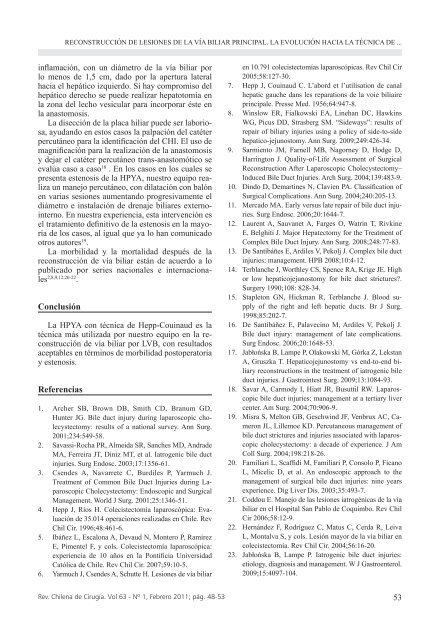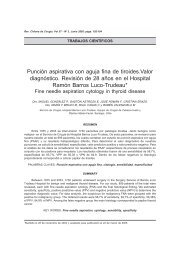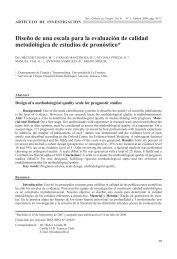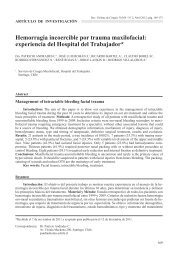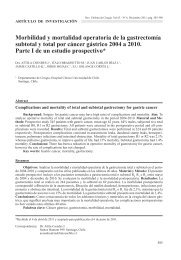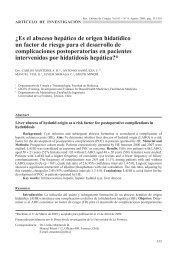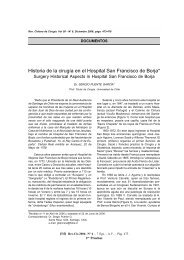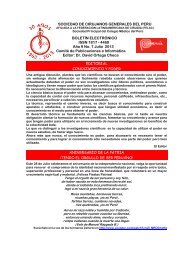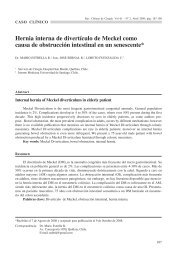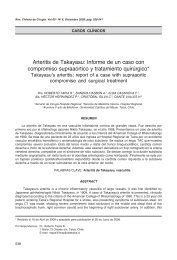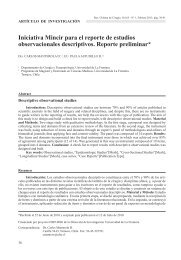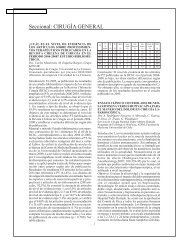cirugia 1-2011.indd - Sociedad de Cirujanos de Chile
cirugia 1-2011.indd - Sociedad de Cirujanos de Chile
cirugia 1-2011.indd - Sociedad de Cirujanos de Chile
You also want an ePaper? Increase the reach of your titles
YUMPU automatically turns print PDFs into web optimized ePapers that Google loves.
RECONSTRUCCIÓN DE LESIONES DE LA VÍA BILIAR PRINCIPAL. LA EVOLUCIÓN HACIA LA TÉCNICA DE ...<br />
inflamación, con un diámetro <strong>de</strong> la vía biliar por<br />
lo menos <strong>de</strong> 1,5 cm, dado por la apertura lateral<br />
hacia el hepático izquierdo. Si hay compromiso <strong>de</strong>l<br />
hepático <strong>de</strong>recho se pue<strong>de</strong> realizar hepatotomía en<br />
la zona <strong>de</strong>l lecho vesicular para incorporar éste en<br />
la anastomosis.<br />
La disección <strong>de</strong> la placa hiliar pue<strong>de</strong> ser laboriosa,<br />
ayudando en estos casos la palpación <strong>de</strong>l catéter<br />
percutáneo para la i<strong>de</strong>ntificación <strong>de</strong>l CHI. El uso <strong>de</strong><br />
magnificación para la realización <strong>de</strong> la anastomosis<br />
y <strong>de</strong>jar el catéter percutáneo trans-anastomótico se<br />
evalúa caso a caso 18 . En los casos en los cuales se<br />
presenta estenosis <strong>de</strong> la HPYA, nuestro equipo realiza<br />
un manejo percutáneo, con dilatación con balón<br />
en varias sesiones aumentando progresivamente el<br />
diámetro e instalación <strong>de</strong> drenaje biliares externointerno.<br />
En nuestra experiencia, esta intervención es<br />
el tratamiento <strong>de</strong>finitivo <strong>de</strong> la estenosis en la mayoría<br />
<strong>de</strong> los casos, al igual que ya lo han comunicado<br />
otros autores 19 .<br />
La morbilidad y la mortalidad <strong>de</strong>spués <strong>de</strong> la<br />
reconstrucción <strong>de</strong> vía biliar están <strong>de</strong> acuerdo a lo<br />
publicado por series nacionales e internacionales<br />
2,8,9,12,20-22 .<br />
Conclusión<br />
La HPYA con técnica <strong>de</strong> Hepp-Couinaud es la<br />
técnica más utilizada por nuestro equipo en la reconstrucción<br />
<strong>de</strong> vía biliar por LVB, con resultados<br />
aceptables en términos <strong>de</strong> morbilidad postoperatoria<br />
y estenosis.<br />
Referencias<br />
1. Archer SB, Brown DB, Smith CD, Branum GD,<br />
Hunter JG. Bile duct injury during laparoscopic cholecystectomy:<br />
results of a national survey. Ann Surg.<br />
2001;234:549-58.<br />
2. Savassi-Rocha PR, Almeida SR, Sanches MD, Andra<strong>de</strong><br />
MA, Ferreira JT, Diniz MT, et al. Iatrogenic bile duct<br />
injuries. Surg Endosc. 2003;17:1356-61.<br />
3. Csen<strong>de</strong>s A, Navarrete C, Burdiles P, Yarmuch J.<br />
Treatment of Common Bile Duct Injuries during Laparoscopic<br />
Cholecystectomy: Endoscopic and Surgical<br />
Management. World J Surg. 2001;25:1346-51.<br />
4. Hepp J, Ríos H. Colecistectomía laparoscópica: Evaluación<br />
<strong>de</strong> 35.014 operaciones realizadas en <strong>Chile</strong>. Rev<br />
Chil Cir. 1996;48:461-6.<br />
5. Ibáñez L, Escalona A, Devaud N, Montero P, Ramírez<br />
E, Pimentel F, y cols. Colecistectomía laparoscópica:<br />
experiencia <strong>de</strong> 10 años en la Pontificia Universidad<br />
Católica <strong>de</strong> <strong>Chile</strong>. Rev Chil Cir. 2007;59:10-5.<br />
6. Yarmuch J, Csen<strong>de</strong>s A, Schutte H. Lesiones <strong>de</strong> vía biliar<br />
en 10.791 colecistectomías laparoscópicas. Rev Chil Cir<br />
2005;58:127-30.<br />
7. Hepp J, Couinaud C. L’abord et l’utilisation <strong>de</strong> canal<br />
hepatic gauche dans les reparations <strong>de</strong> la voie biliaire<br />
principale. Presse Med. 1956;64:947-8.<br />
8. Winslow ER, Fialkowski EA, Linehan DC, Hawkins<br />
WG, Picus DD, Strasberg SM. “Si<strong>de</strong>ways”: results of<br />
repair of biliary injuries using a policy of si<strong>de</strong>-to-si<strong>de</strong><br />
hepatico-jejunostomy. Ann Surg. 2009;249:426-34.<br />
9. Sarmiento JM, Farnell MB, Nagorney D, Hodge D,<br />
Harrington J. Quality-of-Life Assessment of Surgical<br />
Reconstruction After Laparoscopic Cholecystectomy–<br />
Induced Bile Duct Injuries. Arch Surg. 2004;139:483-9.<br />
10. Dindo D, Demartines N, Clavien PA. Classification of<br />
Surgical Complications. Ann Surg. 2004;240:205-13.<br />
11. Mercado MA. Early versus late repair of bile duct injuries.<br />
Surg Endosc. 2006;20:1644-7.<br />
12. Laurent A, Sauvanet A, Farges O, Watrin T, Rivkine<br />
E, Belghiti J. Major Hepatectomy for the Treatment of<br />
Complex Bile Duct Injury. Ann Surg. 2008;248:77-83.<br />
13. De Santibáñes E, Ardiles V, Pekolj J. Complex bile duct<br />
injuries: management. HPB 2008;10:4-12.<br />
14. Terblanche J, Worthley CS, Spence RA, Krige JE. High<br />
or low hepaticojejunostomy for bile duct strictures.<br />
Surgery 1990;108: 828-34.<br />
15. Stapleton GN, Hickman R, Terblanche J. Blood supply<br />
of the right and left hepatic ducts. Br J Surg.<br />
1998;85:202-7.<br />
16. De Santibáñez E, Palavecino M, Ardiles V, Pekolj J.<br />
Bile duct injury: management of late complications.<br />
Surg Endosc. 2006;20:1648-53.<br />
17. Jabłońska B, Lampe P, Olakowski M, Górka Z, Lekstan<br />
A, Gruszka T. Hepaticojejunostomy vs end-to-end biliary<br />
reconstructions in the treatment of iatrogenic bile<br />
duct injuries. J Gastrointest Surg. 2009;13:1084-93.<br />
18. Savar A, Carmody I, Hiatt JR, Busuttil RW. Laparoscopic<br />
bile duct injuries: management at a tertiary liver<br />
center. Am Surg. 2004;70:906-9.<br />
19. Misra S, Melton GB, Geschwind JF, Venbrux AC, Cameron<br />
JL, Lillemoe KD. Percutaneous management of<br />
bile duct strictures and injuries associated with laparoscopic<br />
cholecystectomy: a <strong>de</strong>ca<strong>de</strong> of experience. J Am<br />
Coll Surg. 2004;198:218-26.<br />
20. Familiari L, Scaffidi M, Familiari P, Consolo P, Ficano<br />
L, Micelic D, et al. An endoscopic approach to the<br />
management of surgical bile duct injuries: nine years<br />
experience. Dig Liver Dis. 2003;35:493-7.<br />
21. Coddou E. Manejo <strong>de</strong> las lesiones iatrogénicas <strong>de</strong> la vía<br />
biliar en el Hospital San Pablo <strong>de</strong> Coquimbo. Rev Chil<br />
Cir 2006;58:12-9.<br />
22. Hernán<strong>de</strong>z F, Rodríguez C, Matus C, Cerda R, Leiva<br />
L, Montalva S, y cols. Lesión mayor <strong>de</strong> la vía biliar en<br />
colecistectomía. Rev Chil Cir. 2004;56:16-20.<br />
23. Jabłońska B, Lampe P. Iatrogenic bile duct injuries:<br />
etiology, diagnosis and management. W J Gastroenterol.<br />
2009;15:4097-104.<br />
Rev. <strong>Chile</strong>na <strong>de</strong> Cirugía. Vol 63 - Nº 1, Febrero 2011; pág. 48-53<br />
53


